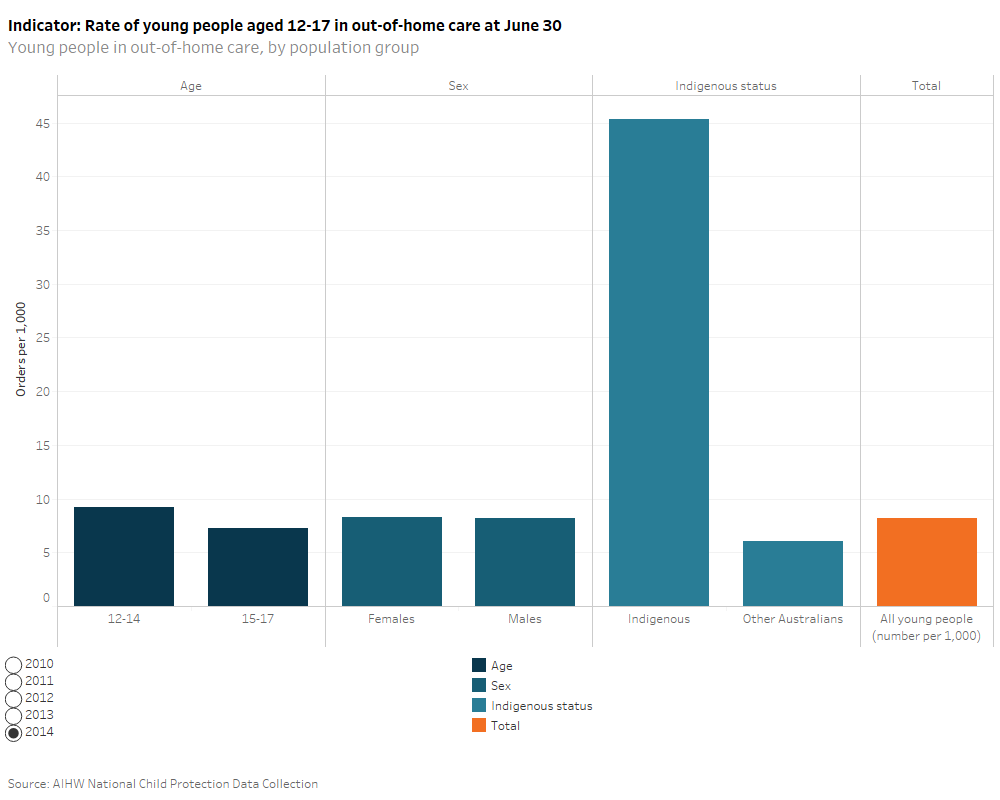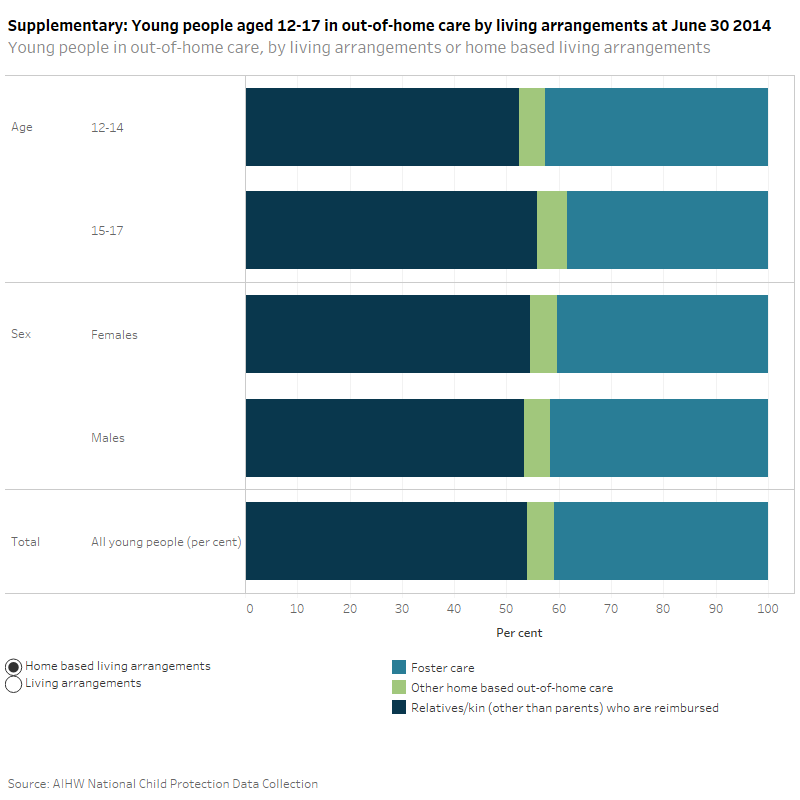Child protection: out-of-home care
What is out-of-home care?
Some young people are placed in out-of-home care because they were the subject of a child protection substantiation and require a more protective environment. Other situations in which a child may be placed in out-of-home care include those where the parents are incapable of providing adequate care for the child, or where alternative accommodation is needed during times of family conflict. There are no national data available on the reasons young people are placed in out-of-home care (For more information, see Child protection Australia: 2013–14) (AIHW 2015).
Out-of-home care is considered an intervention of last resort, with the current emphasis being to keep young people with their families wherever possible. Where young people need to be placed in out-of-home care, an attempt is made to reunite young people with their families. If it is necessary to remove a child from their family, then placement within the wider family or community is preferred. This is particularly the case with Aboriginal and Torres Strait Islander young people, and is outlined in the Aboriginal Child Placement Principle (See ‘Notes’ below).
Do rates vary across population groups?
At 30 June 2014, in the AIHW Child Protection Data Collection, the national rate of young people aged 12–17 living in out-of-home care was 8.2 per 1,000 young people, with little difference between boys and girls (8.2 and 8.3 per 1,000 respectively). Young people aged 12–14 were most likely to be in out-of-home care (9.2 per 1,000 young people) compared with young people aged 15–17 (7.3 per 1,000 young people). Indigenous young people were over 7 times as likely as Other Australian young people to be living in out-of-home care (45.3 per 1,000 Indigenous young people compared with 6.1 per 1,000 Other Australian young people).
Has there been a change over time?
The national rate of young people in out-of-home care increased from 7.0 per 1,000 young people at 30 June 2010 to 8.2 per 1,000 at 30 June 2014. For Indigenous young people, the rate has increased from 35 per 1,000 at 30 June 2010 to 45 per 1,000 at 30 June 2014.
What are the living arrangements for young people in out-of-home care?
In 2014 nearly 85% of young people in out-of-home-care lived in home-based out-of-home care, and a further 13% lived in residential care. Young people aged 15–17 were more likely to live in residential care (18%) than 12–14 year olds (9.3%). Males were also more likely to live in residential care (15%) compared with females (11%). Of those living in home-based care, over half (54%) were living with relatives/kin (other than parents) who were reimbursed. Around 41% were living in foster care. Young people aged 15–17 were slightly more likely than those aged 12–14 to live with relatives/kin (other than parents) who were reimbursed (56% compared with 52%).


In Australia, child protection is the responsibility of state and territory governments. The AIHW collects and reports national data on child protection notifications, investigations, substantiations and other components of the child protection system. While the child protection systems and processes are broadly similar in each jurisdiction, child protection legislation, policies and practices vary. Therefore, caution needs to be taken when comparing child protection data across jurisdictions, or over time.
The Aboriginal Child Placement Principle is one of many considerations taken into account when deciding on placements for Indigenous young people. This Principle has the following order of preference for the placement of Indigenous young people: with the child’s extended family, within the child’s Indigenous community then with other Indigenous people (for more information, see Source data tables: NYIF indicators).
'Residential care' is an out-of-home care placement in a residential building with paid staff whose purpose is to provide placements for young people.
'Family group homes' are homes provided by a department or community-sector agency that have live-in, non-salaried carers who are reimbursed and /or subsidised for the provision of care.
‘Home based care’ are placements in the home of a carer who may be for the cost of the care of the young person. There are 3 categories of home-based out-of-home care: relatives/kin who are reimbursed, foster care, and other home-based out-of-home care.
‘Family care’ is where the child is residing with parents (natural or adoptive) or other relatives/kin (other than parents) who are not reimbursed.
‘Relatives/kin who are reimbursed’ are where the caregiver is: a relative (other than parents) or considered to be family or a close friend; who may be reimbursed for expenses incurred in caring for the young person; who is part of an ongoing review process.
'Foster care' is a form of out-of-home care where the caregiver is authorised and may be reimbursed for the care of the young person. Foster carers may be relatives of the young person being cared for and some relative carers may be registered foster carers.
'Other home-based care' includes young people in a home-based out-of-home care placement other than with relatives/kin who are reimbursed or in foster care.
'Independent living' includes private board and lead tenant households.
For further information on different types of living types of living arrangements and their definitions please refer to the Source data tables: NYIF indicators.
For data disaggregated by Indigenous status, ‘Other Australians’ includes non-Indigenous young people and young people for whom Indigenous status was unknown. In 2013–14, Indigenous status was unknown for around 0.1% of young people who were placed in out-of home care.
From 2012–13, the Child Protection data collection reports unit record level data, which replaces the aggregate data previously used for national reporting. NSW and Queensland data for 2012–13 and 2013–14 were provided at aggregate level.
For more information on child protection processes and data, see Child protection Australia: 2013–14.
AIHW Child Protection Data Collection
Data quality statement: AIHW METeOR
AIHW (Australian Institute of Health and Welfare) 2015. Child protection Australia: 2013–14. Child Welfare series no. 61. Cat. no. CWS 52. Canberra: AIHW.


